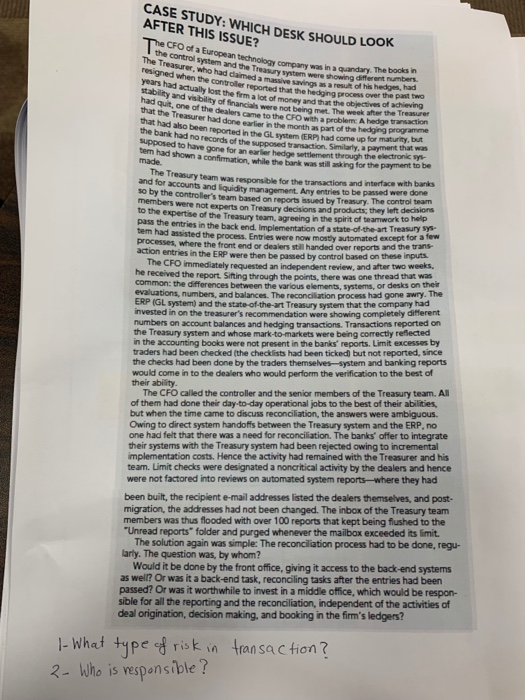CASE STUDY: WHICH DESK SHOULD LOOK AFTER THIS ISSUE? The CFO of a European technology company was in d the control system and the Tr The Treasurer, who had dem e m were showing me any was in a quandary. The books in e r had damdam ed when the controller recorded that the heading process over the pe i ngs c hished , years had actually actually lost the fem a lot of money and that the objectives of achieving ty and visibility of financia r e not being me the week after the Treasure ut, one of the dealers came to the CFO with a problem. A hedge track what the Treasurer had done the months of the hedging program had also been reported the G F RP bad come up formaturity, but me bank had no records of the woo d y , a payment that supposed to have gone for hedeement through the stone er had shown a confirmation while wa w ing for the payent to made The Treasury team was responsible for the a ctions and intace with banks and for accounts and loud met Antries to be passed were done e d by Treasury. The controlam 10 by the controler's team based on report deco members were not experts on Treasury decisions and products that the expertise of the Treasury team, agreeing in the spirit of teamwork to help state of the art Treasury pass the entries in the back and implementation of tomated except for sem had assisted the process Engles were now Mot handed over reports and the Vans processes, where the front end or dealers action entries in the ERP were then be passed by control based on these inputs The CFO immediately requested an independent review, and her two weeks, he received the report Sining through the points, there was one thread that was common: the differences between the various elements, wystems, or desks on the evaluations, numbers, and balances. The reconciliation process had gone awry. The ERP (GL system and the state-of-the-art Treasury system that the company had invested in on the treasurer's recommendation were showing completely different numbers on account balances and hedging transactions. Transactions reported on the Treasury system and whose mark-to markets were being correctly reflected in the accounting books were not present in the banks' reports. Limit excesses by traders had been checked the checklists had been ticked but not reported, since the checks had been done by the traders themselves system and banking reports would come into the dealers who would perform the verification to the best of their ability The CFO called the controller and the senior members of the Treasury team. Al of them had done their day-to-day operational jobs to the best of their abilities, but when the time came to discuss reconciliation, the answers were ambiguous. Owing to direct system handoff's between the Treasury system and the ERP, no one had felt that there was a need for reconciliation. The banks offer to integrate their systems with the Treasury system had been rejected owing to incremental implementation costs. Hence the activity had remained with the Treasurer and his team. Limit checks were designated a noncritical activity by the dealers and hence were not factored into reviews on automated system reports-where they had been built, the recipient e-mail addresses listed the dealers themselves, and post- migration, the addresses had not been changed. The inbox of the Treasury team members was thus flooded with over 100 reports that kept being fushed to the "Unread reports" folder and purged whenever the mailbox exceeded its limit. The solution again was simple: The reconciliation process had to be done, regu- larly. The question was, by whom? Would it be done by the front office, giving it access to the back-end systems as well? Or was it a back-end task, reconciling tasks after the entries had been passed? Or was it worthwhile to invest in a middle office, which would be respon- sible for all the reporting and the reconciliation, independent of the activities of deal origination, decision making, and booking in the firm's ledgers? transaction? 1- What type of risk in 2- Who is responsible? CASE STUDY: WHICH DESK SHOULD LOOK AFTER THIS ISSUE? The CFO of a European technology company was in d the control system and the Tr The Treasurer, who had dem e m were showing me any was in a quandary. The books in e r had damdam ed when the controller recorded that the heading process over the pe i ngs c hished , years had actually actually lost the fem a lot of money and that the objectives of achieving ty and visibility of financia r e not being me the week after the Treasure ut, one of the dealers came to the CFO with a problem. A hedge track what the Treasurer had done the months of the hedging program had also been reported the G F RP bad come up formaturity, but me bank had no records of the woo d y , a payment that supposed to have gone for hedeement through the stone er had shown a confirmation while wa w ing for the payent to made The Treasury team was responsible for the a ctions and intace with banks and for accounts and loud met Antries to be passed were done e d by Treasury. The controlam 10 by the controler's team based on report deco members were not experts on Treasury decisions and products that the expertise of the Treasury team, agreeing in the spirit of teamwork to help state of the art Treasury pass the entries in the back and implementation of tomated except for sem had assisted the process Engles were now Mot handed over reports and the Vans processes, where the front end or dealers action entries in the ERP were then be passed by control based on these inputs The CFO immediately requested an independent review, and her two weeks, he received the report Sining through the points, there was one thread that was common: the differences between the various elements, wystems, or desks on the evaluations, numbers, and balances. The reconciliation process had gone awry. The ERP (GL system and the state-of-the-art Treasury system that the company had invested in on the treasurer's recommendation were showing completely different numbers on account balances and hedging transactions. Transactions reported on the Treasury system and whose mark-to markets were being correctly reflected in the accounting books were not present in the banks' reports. Limit excesses by traders had been checked the checklists had been ticked but not reported, since the checks had been done by the traders themselves system and banking reports would come into the dealers who would perform the verification to the best of their ability The CFO called the controller and the senior members of the Treasury team. Al of them had done their day-to-day operational jobs to the best of their abilities, but when the time came to discuss reconciliation, the answers were ambiguous. Owing to direct system handoff's between the Treasury system and the ERP, no one had felt that there was a need for reconciliation. The banks offer to integrate their systems with the Treasury system had been rejected owing to incremental implementation costs. Hence the activity had remained with the Treasurer and his team. Limit checks were designated a noncritical activity by the dealers and hence were not factored into reviews on automated system reports-where they had been built, the recipient e-mail addresses listed the dealers themselves, and post- migration, the addresses had not been changed. The inbox of the Treasury team members was thus flooded with over 100 reports that kept being fushed to the "Unread reports" folder and purged whenever the mailbox exceeded its limit. The solution again was simple: The reconciliation process had to be done, regu- larly. The question was, by whom? Would it be done by the front office, giving it access to the back-end systems as well? Or was it a back-end task, reconciling tasks after the entries had been passed? Or was it worthwhile to invest in a middle office, which would be respon- sible for all the reporting and the reconciliation, independent of the activities of deal origination, decision making, and booking in the firm's ledgers? transaction? 1- What type of risk in 2- Who is responsible







